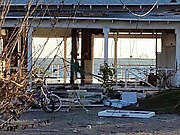By KHRISNA VIRGIL
Tribune Staff Reporter
kvirgil@tribunemedia.net
CHIEF Meteorologist Basil Dean said yesterday that the rapid evolution of Hurricane Joaquin into a category four monster storm raises the question of whether the government should consider implementing new protocols as a proactive measure for quick forming weather systems.
Mr Dean also responded to criticism that the Department of Meteorology and the National Emergency Management Agency (NEMA) did not adequately inform the central and southern Bahamas of the approaching hurricane.
During an interview with The Tribune, he said critics needed to only look at the number of alerts that were issued – 27 in total – and when they were sent to get an idea of how officials tracked and informed the public of Joaquin’s movement.
Hurricane Joaquin evolved into a category four storm last Thursday.
Joaquin evolved into a dangerous storm in just 24 hours.
Residents in the southern Bahamas, such as Acklins and Crooked Island, have said they were caught off guard by the fierce hurricane and did not have time to properly prepare.
Mr Dean also spoke at the Rotary Club of West Nassau’s weekly luncheon on this country’s challenges and preparations during the hurricane season.
He said the Bahamas, with its 18 inhabited islands stretching from 50 miles east of the Florida coast to about 50 miles off the northeast coast of Cuba, has only one meteorological service to provide coverage and warnings.
Mr Dean said a warning system has been adopted that is designed to give 48 and 36 hour lead times to effect preparation and/or evacuation where necessary in order to minimise damage and the loss of life due to wind, rain or storm surge.
“In conclusion, over the years much improvement has been made in track forecast, however intensity forecasting still remain a challenge and this is why preparedness protocols for a tropical storm is the same for a hurricane,” he said.
“Last week was a classical case of how rapidly tropical cyclones can develop.
“Lesson learned. What protocols need to be put in place to deal with hurricanes which form on your doorsteps? The debate is open.”
On Sunday, September 27, at 11pm officials said a tropical storm had developed. The next day at around 5am an alert was issued and last week Tuesday it developed into a tropical depression, Mr Dean said.
At 8am on September 30, Joaquin became a hurricane and by 11pm the storm was clocking 115 mph winds.
However, a statement issued by NEMA on September 30, said at that time a hurricane warning was in effect for the central Bahamas which includes the islands of Long Island, Exuma and its cays, Cat Island, Rum Cay and San Salvador.
At the time, a hurricane watch was in effect for the northwest Bahamas – Eleuthera, Abaco, New Providence, Andros, the Berry Islands, Bimini and Grand Bahama.
A tropical storm warning was also put out for the southeast Bahamas, including Crooked Island and Acklins.
By early Thursday, October 1, the hurricane mushroomed into a ferocious category four system with 130mph winds. By that time the Meteorological Office issued a hurricane warning for the whole country.
Joaquin has flattened homes, buildings and caused severe flooding leaving devastation behind in Acklins, Long Island, San Salvador, Long Cay, Crooked Island and Rum Cay.
MICAL MP V Alfred Gray has suggested that “heads should roll” over the response of some government agencies to Joaquin. He said the Department of Meteorology and NEMA could have done a better job with their advisories and warning, insisting that agencies were “seemingly caught off guard”.





Comments
Use the comment form below to begin a discussion about this content.
Sign in to comment
Or login with:
OpenID